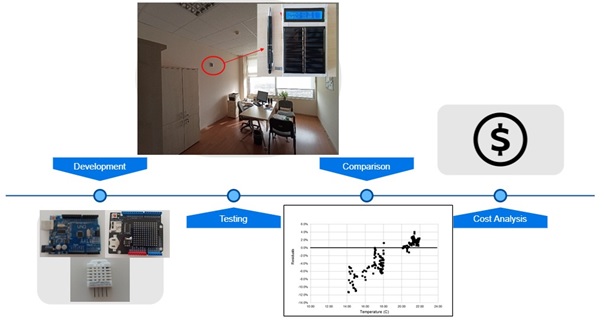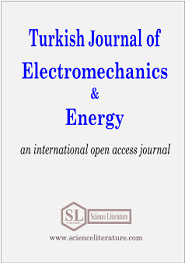
Development of a solar-based temperature and relative humidity data logger
Abstract
Data loggers measure indoor air parameters such as temperature and relative humidity by using several sensors in buildings. These parameters are the most crucial factor in calibrating energy simulation programs. However, data loggers are very expensive and require hard-to-understand hardware to store data. In addition, these devices use standard lithium batteries to supply the energy of sensors. However, some of the data can be missed due to the low battery life of the data loggers. Furthermore, tracking the measured data is very difficult since they require additional software, which is confusing for engineers and architects. This study aims to develop a solar power-based low-cost data logger and record the measured data as an excel file into the micro SD card. For hardware purposes, a temperature and humidity sensor, an Arduino microcontroller card, a micro SD card module, a solar panel, and a battery unit are used while software codes are written to generate permanent data. The low-cost temperature and relative humidity data logger prototype is manufactured and tested in a case building at Atılım University in Ankara/Turkey. Then, the developed data logger is compared with the HOBO-U12 data logger during four days. The results show that the cost of the data logger can be decreased by approximately 82%. In comparison, the accuracy of the data is 97% and 96% for temperature and relative humidity, respectively, compared to the commercial data logger.
Full Text:
PDFReferences
N. Eskin and H. Türkmen, “Analysis of annual heating and cooling energy requirements for office buildings in different climates in Turkey,” Energy and Buildings, 40(5), pp. 763-773, 2008.
A.H. Buchanan and B. G. Honey, “Energy and carbon dioxide implications of building construction,” Energy and Buildings, 20(3), pp. 205-217, 1994.
I.Z.Bribián, A.V. Capilla and A.A. Usón, “Life cycle assessment of building materials: Comparative analysis of the energy and environmental impacts and evaluation of the eco-efficiency improvement potential,” Building and Environment, 46 (5), pp. 1133-1140, 2011.
J. E. Games, W.W. Bitterly and D.M. Healy, United States Patent No. US4205381A, 1997.
F.C. McQuiston J.D. Parker and J.D. Spitler, Ventilating, and Air Conditioning: Analysis and Design. 1. Ed. US: John Wiley&Sons, pp. 123-125, 2004.
B. Dong, C.Cao and S.E. Lee, “Applying support vector machines to predict building energy consumption in tropical region,” Energy and Buildings, 37(5), pp. 545-553, 2005.
M. Barbason and S. Reiter, “Coupling building energy simulation and computational fluid dynamics: Application to a two-storey house in a temperate climate,” Building and Environment, vol. 75, pp. 30-39, 2014.
M. Nadarajan and V. Kirubakaran, “Simulation tools for residential building: A review on concept and technologies,” Journal of Engineering and Applied Science, 11(5), pp. 2998-3007, 2016.
T. A. Reddy, “Literature Review on Calibration of Building Energy Simulation Programs: Uses, Problems, Procedures, Uncertainty, and Tools,” ASHRAE Journal, 112(1), pp. 226-240, 2006.
M. Manfren, N. Aste and R. Moshksar, “Calibration and uncertainty analysis for computer models – A meta-model based approach for integrated building energy simulation,” Applied Energy, vol. 103, pp. 627-641, 2013.
M. B. Waghmare and P.N. Chatur, “Temperature and Humidity Analysis using Data Logger of Data Acquisition System: An Approach,” International Journal of Emerging Technology and Advanced Engineering, 2(1), pp. 102-106, 2012.
G. S. Nhivekar and R. R. Mudholkar, “Datalogger and remote sensing system for multiple parameter measurement applications,” E-Journal of Science and Technology, vol. 1, pp. 55-62, 2011.
F. Haghighat and L. de Bellis, “Material emission rates: Literature review, and the impact of indoor air temperature and relative humidity,” Building and Environment, 33(5), pp. 261-277, 1998.
J. Frisby, D. Raftery, J. P. Kerry, and D. Diamond, “Development of an autonomous, wireless pH and temperature sensing system for monitoring pig meat quality,” Meat Science, 70(2), pp. 329-336, 2005.
M. A. B. Sidik, M. Q. A. Rusli, Z. Adzis, Z. Buntat, Y. Z. Arief, H. Shahroom, Z. Nawawi and M.I. Jambak, “Arduino-Uno based mobile data logger with GPS feature,” Telkomnika, 13(1), pp. 250-259, 2015.
A. S. Ali, Z. Zanzinger, D. Debose and B. Stephens, “Open Source Building Science Sensors (OSBSS): A low-cost Arduino-based platform for long-term indoor environmental data collection,” Building and Environment, vol. 100, pp. 114-126, 2016.
A. M. Shuvo, M.M. Rahman, A. T. Nahian, and T. F. Himel, “Design & Implementation of a Low-Cost Data Logger for Solar Home System,” International Journal of Engineering and Management Research, 9(1), pp. 32-40, 2019.
M. Bogdan, “How to Use the DHT22 Sensor for Measuring Temperature and Humidity with the Arduino Board,” Acta Universitatis Cibiniensis, Technical Series, 68 (1), pp. 22-25, 2016.
C. Y. Wen, C. Y. Jhu, Y. W. Wang, C. C. Chiang, and C. M. Shu, “Thermal runaway features of 18650 lithium-ion batteries for LiFePO4 cathode material by DSC and VSP2,” Journal of Thermal Analysis and Calorimetry, vol. 109, pp. 1297-1302, 2012.
J. Benesty, J. Chen, Y. Huang and I. Cohen, Pearson Correlation Coefficient. Noise Reduction in Speech Processing, vol 2. Berlin: Springer, 2009.
Onset, “Onset HOBO Temperature/Relative Humidity/2 External Channel Data Logger,” [Online]. Available: https://www.onsetcomp.com/products/data-loggers/u12-013 [Accessed: Nov. 01, 2020].
Onset, “Onset HOBO Ware,” [Online]. Available: https://www.onsetcomp.com/products/software/hoboware/https://www.onsetcomp.com/products/software/hoboware/ [Accessed: May. 14, 2020].
URN: https://sloi.org/urn:sl:tjoee61174
Copyright (c) 2021 Turkish Journal of Electromechanics and Energy

This work is licensed under a Creative Commons Attribution-NonCommercial 4.0 International License.

 Indexed in:
Indexed in:
















